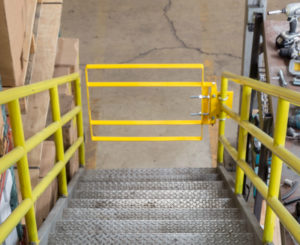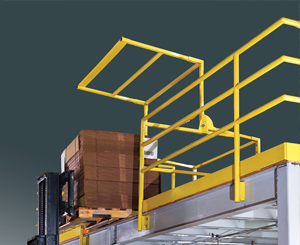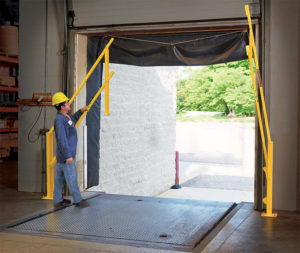
Falls are the most common cause of industrial workplace injuries, per OSHA. They are costly accidents, resulting in lost productivity, reduced revenue, and increased expenses. Regularly inspecting your facility and addressing potentially hazardous areas is essential. Not only does it protect the safety of workers, contractors, and visitors, it ensures you’re in compliance with OSHA standards. So it’s vital that you monitor key areas to make sure that they are well protected and that the fall risks are minimized with safety gates and other fall protection devices. This guide will help you get started.
Common Fall Hazards
Industrial facilities are full of people, machines, equipment, tools, and activity. Along with all that movement, there are also a multitude of potential hazards. From the moment someone, employee or not, steps in the door, they are at risk from a slip and fall accident. And as one proceeds deeper into the facility, even more obstacles and hazards await. Identifying the most dangerous areas and addressing them will ensure that no one gets hurt and that production can continue without interruption.
Entryways
Wet conditions, mud, dirt, and other debris in the entryway of a building create a slippery, dangerous situation. This is even more complicated in the winter months with ice, snow, and salt added to the mix. The simple act of walking through the door can cause injuries, in fact, 51% of slip and fall accidents occur at the entrance of a building. Protect your employees, contractors, and visitors by following these simple steps:
- Install moisture absorbing, rubber backed mats for people to wipe their feet before and just after entering the building.
- Keep the mats flat and the surrounding areas mopped and swept to avoid slips.
- Keep customer and employee entryways well-lit.
- Keep areas free of debris, equipment, and other hazards.
Walkways
Whether your facility’s walkways are corridors through the building, or paths through the shop, it’s imperative that they do not pose a trip and fall hazard. Forklifts and other equipment, foot traffic, and a myriad of other activities depend upon these areas being accessible. To ensure safety, and accessibility, pay close attention to the following:
- Keep equipment, tools, materials, and supplies out of the walkway area.
- Maintain adequate width for equipment to pass through.
- Mark walkway areas with contrasting paint to denote direction and path.
- Keep walkways well-lit.
- Install safety gates to protect workers and visitors from dangerous equipment and fall hazards.
Stairways

- Stairways must have adequate lighting so that workers can clearly see what’s ahead when ascending or descending the stairs.
- The stair treads need to be uniform and contrast with the stair’s color for high visibility.
- Keep stairways clear of any debris, equipment, or other items.
- Finally, protect workers from falls by installing OSHA compliant safety gates
Mezzanines

- Workers at the upper level must be protected from falls with mezzanine gates and perhaps additional safety equipment like harnesses.
- Mezzanine gates also help keep materials, supplies, and tools from dropping down to the lower level.
- At lower levels, safety gates protect ladder access areas and minimize slip and fall hazards.
- Hard hats and other safety equipment helps keep lower-level workers protected from falling tools and debris.
Loading Docks

- Provide adequate lighting at the loading dock entrance and surrounding area.
- Marking stairways and ramps in the manner noted above.
- Installing heavy-duty safety rails and gates in accordance with OSHA regulations on loading dock safety.
- In addition to rails and/or barriers, marking the edges of the dock with bright, contrasting color to make them stand out.
Ladders
An often overlooked fall hazard is the common ladder. They’re a quick way to get up to another level of the facility or to reach an area of the machine that needs to be fixed. Climbing or descending one that is not protected and secured properly, however, is a dangerous proposition. This is especially true when the worker is carrying heavy loads of tools and supplies with them.
- Take note of the ladders being used, and how frequently.
- Remove unused ladders or those that are in disrepair.
- Clear the areas at the top and bottom of the ladder at all times.
- Use pulley systems to bring materials up and down, rather than carrying them.
- Use safety rails and gates to ensure those using the ladder and those working around them stay safe.
Maintaining a safe industrial facility work environment is a requirement by OSHA. Failing to provide adequate protections will result in fines, but more so, it makes working in your facility dangerous. You’ll have a harder time attracting the talent you need, and you’ll lose your good reputation for safety if someone gets hurt. Keep your facility in compliance, avoid OSHA fines, and maintain excellent safety standards by installing safety gates, mezzanine gates, and loading dock safety mechanisms. Providing employees with personal fall protection safety and ongoing safety training as well will further ensure everyone stays safe and protected in any industrial facility.







